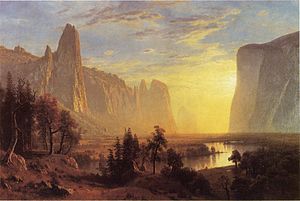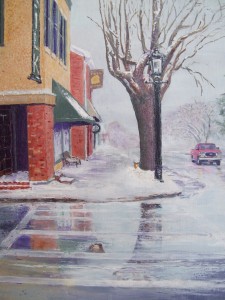There can be subtle or significant factors that can effect the color of light. As an artist, one must be certain to observe these diverse factors and treat them with respect. Learning to portray these subtleties will enhance a painting and make it much more believable.

There are many great artist that have mastered painting environmental elements that affected the color of light. Although the artist, Albert Bierstadt, was often criticized for enhancing light, he did not fail to properly portray it in his many beautiful landscapes.
Of course the quality of air is affected in nature by humidity. The more humid it is, the denser the air. Objects tend to be blue or gray in the distance. Exactly the opposite is true when there is no humidity in the atmosphere. The light is clear. The darker colors do not fade into blue or gray as rapidly.

While painting “The Red Truck”, I had to keep in mind the graying of the colors as they became affected by the atmosphere. Clouds play a major role in the color of light. They may entirely or partially block the sun.
In the case of the painting, clouds completely blocked out the sun. The color of light on the snow was mostly gray-white rather than yellow-white as it would have been had the sun been shining on it. Shadows were warmer with touches of pinks and lavenders. The trees barely a block away were disappearing in a curtain of blue-gray-pink cast.
As artists, we must be good observers because we see what most people simply take for granted. It is the color of light that creates many of our moods without us realizing it. As an artist, we learn to portray the colors we see. Therefore, we have the magic to create moods.
